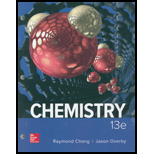
Concept explainers
Interpretation:
For the given nuclear reaction, X should be identified and the equation should be balanced.
Concept Introduction:
- Nuclear reaction can be written in the shorthand notation with the parentheses. Bombarding particle, that is projectile can be represented as first symbol in the parentheses and the emitted particle that is ejected which can be represented as the second particle in the parentheses.
Parent nucleus and daughter nucleus can be represented in the front part of the parentheses and back part of the parentheses respectively.
- On accordance with law of conservation of mass, for any
chemical reaction , total masses of reactants and products must be equal.
To find: The value of X in the given
Answer to Problem 19.61QP
Explanation of Solution
Nuclear reaction can be written in the shorthand notation with the parentheses. Bombarding particle, that is projectile can be represented as first symbol in the parentheses and the emitted particle that is ejected which can be represented as the second particle in the parentheses. Parent nucleus and daughter nucleus can be represented in the front part of the parentheses and back part of the parentheses respectively. So for any nuclear reaction, short hand notation will be in this form that is,
For the given reaction a, Short hand notation is

The given chemical equation can be written as,
On accordance with law of conservation of mass, for any chemical reaction, total masses of reactants and products must be equal. So the X will be
So the balanced equation can be written as,
Find the value of X in the given nuclear equation (b)
For the given reaction b, Shorthand notation is
The given chemical equation can be written as,
On accordance with law of conservation of mass, for any chemical reaction, total masses of reactants and products must be equal. So the X will be
So the balanced equation can be written as,
Find the value of X in the given nuclear equation (c).
For the given reactions, Shorthand notation is
The given chemical equation can be written as,
On accordance with law of conservation of mass, for any chemical reaction, total masses of reactants and products must be equal. So X will be
So the balanced equation can be written as,
Find the value of X in the given nuclear equation (d).
For the given reactions, Shorthand notation is
The given chemical equation can be written as,
On accordance with law of conservation of mass, for any chemical reaction, total masses of reactants and products must be equal. So X will be
So the balanced equation can be written as,
For the given nuclear reaction, X is identified and the equation was balanced.
Want to see more full solutions like this?
Chapter 19 Solutions
CHEMISTRY (LOOSELEAF) >CUSTOM<
- Show the mechanism steps to obtain the lowerenergy intermediate: *see imagearrow_forwardSoap is made by the previous reaction *see image. The main difference between one soap and another soap isthe length (number of carbons) of the carboxylic acid. However, if a soap irritates your skin, they mostlikely used too much lye.Detergents have the same chemical structure as soaps except for the functional group. Detergentshave sulfate (R-SO4H) and phosphate (R-PO4H2) functional groups. Draw the above carboxylic acidcarbon chain but as the two variants of detergents. *see imagearrow_forwardWhat are the reactions or reagents used? *see imagearrow_forward
- The two pKa values of oxalic acid are 1.25 and 3.81. Why are they not the same value? Show the protontransfer as part of your explanation. *see imagearrow_forwardасть Identify all the bonds that gauche interact with C-OMe in the most stable conformation of the above compound.arrow_forwardPredict the reactants used in the formation of the following compounds using Acid-Catalyzed dehydration reactionarrow_forward
- Can I please get help with this?arrow_forward.. Give the major organic product(s) for each of the following reactions or sequences of reactions. Show ll relevant stereochemistry [3 ONLY]. A H Br 1. NaCN 2 NaOH, H₂O, heat 3. H3O+ B. CH₂COOH 19000 1. LiAlH4 THF, heat 2 H₂O* C. CH Br 1. NaCN, acetone 2 H3O+, heat D. Br 1. Mg. ether 3. H₂O+ 2 CO₂ E. CN 1. (CH) CHMgBr, ether 2 H₂O+arrow_forwardAssign this COSY spectrumarrow_forward
 Chemistry: The Molecular ScienceChemistryISBN:9781285199047Author:John W. Moore, Conrad L. StanitskiPublisher:Cengage Learning
Chemistry: The Molecular ScienceChemistryISBN:9781285199047Author:John W. Moore, Conrad L. StanitskiPublisher:Cengage Learning General, Organic, and Biological ChemistryChemistryISBN:9781285853918Author:H. Stephen StokerPublisher:Cengage Learning
General, Organic, and Biological ChemistryChemistryISBN:9781285853918Author:H. Stephen StokerPublisher:Cengage Learning Chemistry: Principles and PracticeChemistryISBN:9780534420123Author:Daniel L. Reger, Scott R. Goode, David W. Ball, Edward MercerPublisher:Cengage LearningChemistry: Matter and ChangeChemistryISBN:9780078746376Author:Dinah Zike, Laurel Dingrando, Nicholas Hainen, Cheryl WistromPublisher:Glencoe/McGraw-Hill School Pub Co
Chemistry: Principles and PracticeChemistryISBN:9780534420123Author:Daniel L. Reger, Scott R. Goode, David W. Ball, Edward MercerPublisher:Cengage LearningChemistry: Matter and ChangeChemistryISBN:9780078746376Author:Dinah Zike, Laurel Dingrando, Nicholas Hainen, Cheryl WistromPublisher:Glencoe/McGraw-Hill School Pub Co Chemistry for Today: General, Organic, and Bioche...ChemistryISBN:9781305960060Author:Spencer L. Seager, Michael R. Slabaugh, Maren S. HansenPublisher:Cengage Learning
Chemistry for Today: General, Organic, and Bioche...ChemistryISBN:9781305960060Author:Spencer L. Seager, Michael R. Slabaugh, Maren S. HansenPublisher:Cengage Learning





